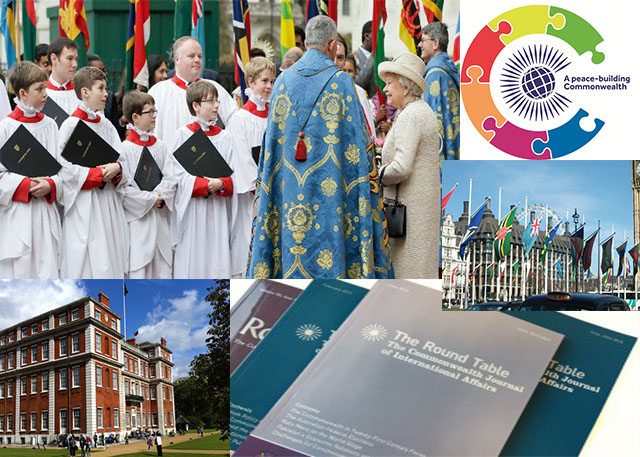 A look back through the archives of the Round Table Journal
A look back through the archives of the Round Table Journal
The Round Table website pages will be regularly dipping into the archives of the Journal to look at past coverage of Commonwealth events.
How did the Commonwealth Day Service move to Westminster Abbey? Round Table archives indicate what happened.
Writing in 1997 for the Round Table Journal, Donald Simpson, librarian for more than 30 years at the Royal Commonwealth Society, looked at 30 years of the Commonwealth Day Service:
In 1966 a Service of Affirmation of Faith was held in the Church of St Martin in the Fields, organized largely by the Vicar, the Revd Austen Williams. The Rt Revd Ronald Goodchild, Suffragan Bishop of Kensington (the only Anglican Bishop ever to take part in these Observances) presided. HM The Queen and HRH The Duke of Edinburgh led a distinguished congregation. Unfortunately the multi-faith character of the service proved very controversial, and the opposition of the Archbishop of Canterbury and the Bishop of London led to the cancellation of any religious observance in 1967, a decision strongly attacked in an editorial in Theology (July 1967). However, the major episcopal objections appeared to be to the use of a Christian Church and the word ‘Service’. These objections were overcome in 1968, when a ‘Multi Faith Act of Witness and Affirmation of Faith’ was held in London’s Guildhall at 6 pm on Commonwealth Day. The stewarding was by younger members of the Joint Commonwealth Societies under the direction of the Librarian of the Royal Commonwealth Society.
The article continues:
HM The Queen attended this first Guildhall Act of Witness, but in ensuing years, although members of the Royal Family were present—the Duke and Duchess of Kent in 1969, the Duchess of Gloucester in 1970 (when it was renamed Multi Faith Act of Witness for the Commonwealth and moved to the eve of Commonwealth Day), and Princess Alexandra and the Hon Angus Ogilvy in 1971—the Queen was understood to be unwilling to attend again until it could be held in a Church.
In 1972 the Very Revd Eric Abbott, Dean of Westminster Abbey, which as a ‘Royal Peculiar’ was not under episcopal authority, invited the JCSC to transfer the occasion there, and at 3 pm on 2 June 1972, the eve of Commonwealth Day, ‘An Observance for Commonwealth Day’ was held. The stewarding was transferred to the Abbey Stewards. Several other changes, to be noted later, were made.
With the decision to make Commonwealth Day the second Monday in March, the Observance was moved in 1977 from the Eve of Commonwealth Day to Commonwealth Day itself. The 1966 service was televised; this has never been repeated, but from an early date it was recorded for later broadcasting in the Overseas Service of the BBC. In 1989 the Observance was broadcast at the time it took place, and effectively began at 3.15, though this was not formalized until 1991. The Observance had been conducted by successive Deans; after Dr Abbott, by the Very Revd Edward Carpenter (1974-1985), and, after the Observance was led by the Sub-Dean in 1986, by the Very Revd Michael Mayne. There is no doubt that the Abbey, with its historical and architectural, as well as spiritual associations, and its ability to seat nearly 2000, forms a splendid setting for this occasion, enhanced as it is by the flowers given by countries of the Commonwealth, in many cases sent by air, and arranged by members of the National Association of Flower Arrangement Societies of Great Britain. The structure of the Abbey does however preclude those seated in the nave from seeing what takes place beyond the screen, and in 1981 it was suggested that St Paul’s Cathedral, with its large open area under the dome,might give scope for a more dramatic presentation of the Commonwealth. The Dean of St Pauls’ enthusiasm for this was not, however, shared by all his Chapter, and the suggestion was dropped. HM The Queen, despite being understood to favour varied events to celebrate Commonwealth Day, has indicated her approval of the Observance by attending it on all but three years when she was absent from London (1974, 1977, and 1986, when she was represented by the Prince of Wales, Princess Anne, and the Prince and Princess of Wales respectively).
Related articles
– ‘They are going to bury the Commonwealth’ – A Canadian perspective from the archives.
– The future of the Commonwealth after World War Two – From the archives.
– From the archives: Why the Commonwealth survives its crises.
Stuart Mole: 2016 – What is Commonwealth Day for?



